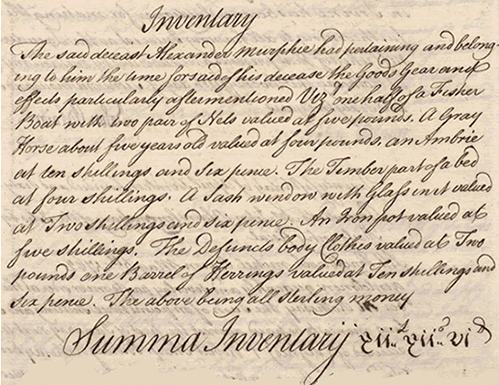7. The Inventory
The inventory lists the movable goods. If there were any debts owing to or by the deceased these would normally be listed as well. In a typical inventory you would expect to find some or all of the following:
- the deceased's means of livelihood (tools, equipment etc)
- the products of work or trade (e.g. agricultural crops and manufactured goods)
- domestic animals (e.g. horses for transport, cows for milk)
- furniture, house fittings, cooking utensils, personal effects and valuables
- clothes
- cash
In addition to the common phrases already encountered in introductory paragraphs, you should expect certain other words and phrases to occur frequently in inventories:
| Line | Term | Definition |
|---|---|---|
| 1 | Inventar/Inventary/Inventarij | the inventory |
| 4 | Viz~ | abbreviation for the Latin videlicet, meaning 'that is to say' |
| 10 | Body clothes | personal clothing |
| 13 | Summa Inventarij | the total value of the inventory |

Crown copyright, National Records of Scotland, CC12/3/6, p16
Inventary
The said deceast Alexander Murphie had pertaining and belong-
ing to him the time forsaid of his decease the Goods Gear and
effects particularly aftermentioned Viz~ one half of a Fisher
Boat with two pairs of Nets valued at five pounds. A Gray
Horse about five years old valued at four pounds, an Ambrie
at ten shillings and six pence. The Timber part of a bed
at four shillings A sash window with Glass in it valued
at Two shillings and six pence. An Iron pot valued at
five shillings. The Defuncts body Clothes valued at Two
pounds one Barrel of Herrings valued at Ten shillings and
six pence. The above being all sterling money
Summa Inventarij xij lib~ xii s~ vi d~
Vocabulary and Dictionaries
Because inventories list livestock, crops, furniture and other movable goods, many of them have names which have long since disappeared from current use. For example, the ambrie (line 6) was an item of furniture serving as a cupboard or sideboard. When reading inventories written in Scotland it is useful to have one or more types of dictionary to hand. Ideally you should have a Scots dictionary but you may also find that occasional access is required to a nineteenth century English dictionary (for archaic words which are not specifically Scots). For advice about Scots and older English dictionaries see the Coaching Manual.
Numerals and Money
In eighteenth century Scotland Roman numerals were giving way to Arabic numerals, but in testaments of this period it is possible to find numbers and sums of money written in Roman numerals, Arabic numerals and long-hand. Sums of money were usually rendered in pounds, shillings and pence in either sterling or pounds Scots. You will need to be able to calculate in pounds, shillings and pence, which was the monetary system in Scotland until the introduction of decimal currency 1971. For more information about numerals and sums of money see the Coaching Manual.
By the mid-eighteenth century, families and creditors used the testamentary process to pursue relatively small amounts of money such as salary owed to the deceased or a specific debt owed by or to the deceased. In cases like this, where only one sum of money is covered by the testament, the clerk would write summa inventary patet. The Latin word patet means 'open' or 'clear'.
Crops and Livestock
Many inventories include crops and livestock and the terminology relating to these might seem baffling when you first encounter it. An explanation of these is outwith the scope of this tutorial - for help with this see the Scottish Archive Network (SCAN) website Weights and Measures Guide.
Exercise 2
An exercise in calculating in pounds, shillings and pence.
For centuries money in Scotland was calculated in pounds, shillings and pence using the following quantities:
- 20 shillings = one pound
- 12 pence = one shilling
- 240 pence = one pound
When writing monetary values down, pounds shillings and pence were abbreviated to L, s and d from their Latin names libra, solidi and denarii. For more about Scots money go to the Coaching Manual page on money.
Using this information, can you tell from the inventory what the total value of the household contents, that is the furniture, sash window, iron pot, clothing and barrel of herring was?
To work out your answer you may find it helpful to use Exercise 2 worksheet (opens in new window).
Read the answer to Exercise 2